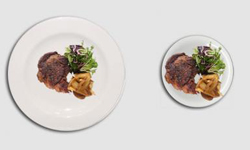Portion size has increased significantly over the past decades, alongside growing rates of obesity. A UNC study found that our serving sizes have increased both inside and outside of the home. The study looked at change in portion sizes from 1977 to 1996 and showed that hamburgers expanded by 23 percent; A plate of Mexican food grew by 27 percent; Soft drinks increased in size by 52 percent; And snacks, whether potato chips, pretzels or crackers, were 60 percent larger. Along with these increases in portion size, the size of dinnerware, such as plates and bowls, has grown as well. The average size of a sample of dinner plates increased almost 23 percent, from 9.6 inches to 11.8 inches, since 1900, according to a recent study. Many obesity experts have suggested that replacing large plates with smaller plates at home could help people exercise better portion control, however, the nature of the link between the sizes of dinnerware and serving biases remains unclear. At The Obesity Society’s annual meeting, researchers gave a talk about perception of portion size and how a concept called the Delboeuf illusion may explain why people eat more when given a larger plate. 
The Delboeuf illusion was first described in 1865, when Franz Joseph Delboeuf, a Belgian philosopher documented the perceived difference in the size of two identical circles, when one of the circles was surrounded by a much larger circle and the other one was surrounded by only a slightly larger circle.
While working on a program at Stanford where they replaced families’ large plates with small ones, researchers wondered if there may be implications of plate design in addition to plate size. They performed a study on plate design, looking at how the rim of the plate affects perception of portion size. They found that – given the same size plate – participants overestimated food portion size when the portion was served on a plate where more of the plate was taken up by a painted rim. The more of the plate that was covered with food, the greater the effect. Participants perceived the amount of food on a plate with a wide rim to be about 11 percent bigger than food with standard rim.
Based on these findings, a person consuming 2000 calories per day could potentially skim more than 200 calories from their daily intake by eating from the same size plate, but with a wider rim. The researchers plan to next test combinations of rim size and colors.
Related Reading: Memory of Food Can Affect Hunger






Nutrition & Lifestyle